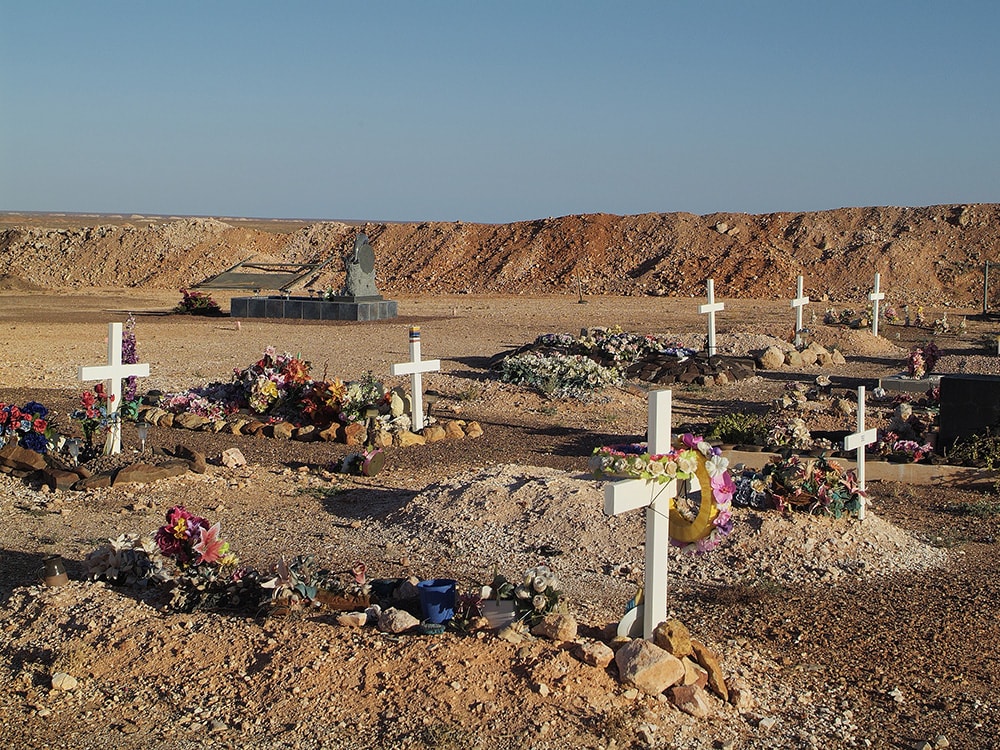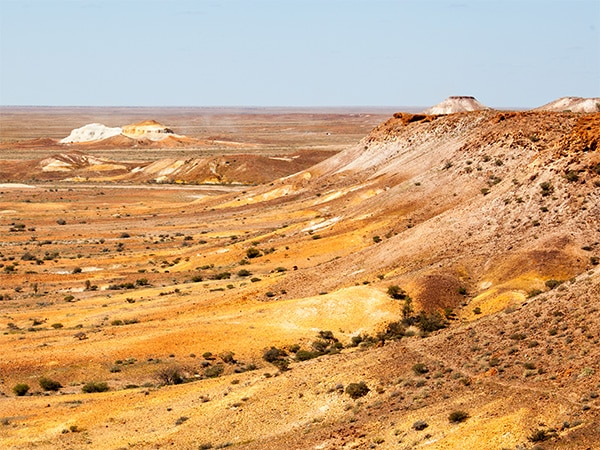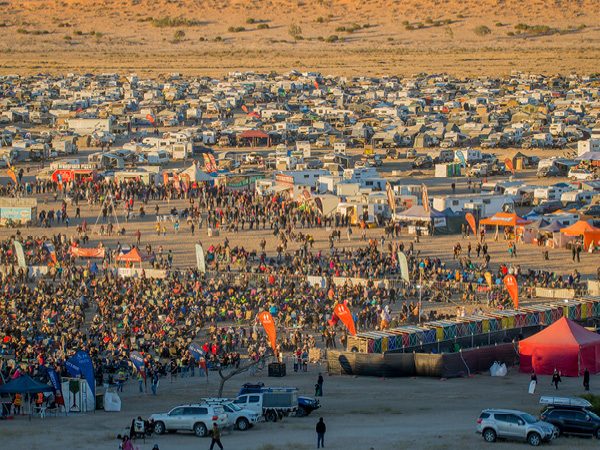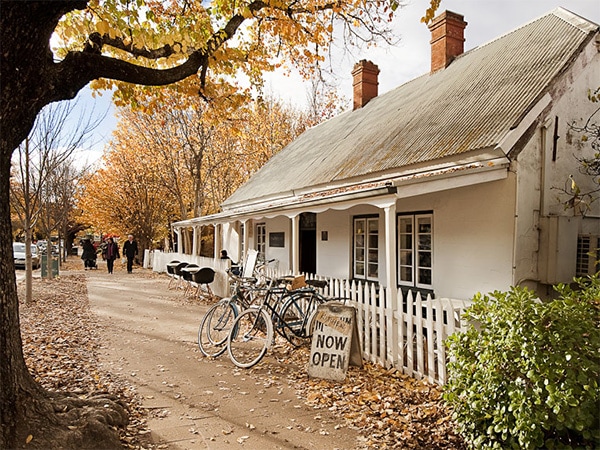17 February 2023
![]() 6 mins Read
6 mins Read

Laying its claim to being the Opal Capital of the World, the Hollywood of the Outback and a place of extreme temperatures, the reason for which most of its locals live underground, the tiny outback town of Coober Pedy is indeed one of the country’s most unusual places.
The reason behind the town’s moniker – an Aboriginal term for ‘white man in a hole’ – the famous Coober Pedy dugouts were introduced by opal mining pioneers in the early 20th century to escape the heat. More than half of the town’s homes are found underground, as well as the four-star Desert Cave Hotel, a campsite and a Siberian Orthodox church.
With the majority of the world’s opals found in Coober Pedy’s 70 opal fields, visitors can try their hand at ‘noodling’ – digging for opal by hand – or tour a working mine. The town is also home to a desert golf course that is open at night, one of the country’s last surviving drive-in movie theatres, and has been the setting for many a movie including Mad Max Beyond the Thunderdome and Priscilla Queen of the Desert.

Coober Pedy is indeed one of the country’s most unusual places
This sleepy village 70 kilometres west of Byron Bay is infamous for its, er, liberal lifestyle. The psychedelic town was thrown into the spotlight when it hosted the 1973 Aquarius Festival, Australia’s version of Woodstock, and it hasn’t shaken this carefree, counter-culture, peace-loving guise ever since.
A wander down the main street is like stepping into an alternate universe. You’ll find myriad wellbeing services from yoga and acupuncture to shamans and psychics; a thriving arts and culture scene of art galleries, street art and buskers; a host of organic/vegan/vegetarian/sustainable food options; and some businesses that specialise in… let’s just say alternative medicinal products.
Who knew a remote town located 380 kilometres north of Alice Springs was considered the UFO Capital of Australia? After reading about sightings during World War 2, one man by the name of Lew Farkas purchased the local roadhouse and, after dropping a cool $4 million, created a gimmicky tourist attraction complete with kitsch UFO murals, spaceships, plastic green aliens and even (a now defunct) toy train.
There is a journal on display where visitors have recorded sightings such as colourful lights that move and change shape, descend behind trees and quickly disappear; even some of which have followed cars.
Sceptics put it all down to aircraft and weather phenomena (or a few too many schooners at the pub), while believers think it’s Wycliffe Well’s geographical location and intense energy that draws these unique visitors in. Others think there’s a link to the nearby US military intelligence base Pine Gap. Whatever the reason, there have been no abductions… as yet.

Have you considered the UFO capital of Australia?
The locals in this Swiss-style settlement, 15 minutes north of Launceston, do not speak any Swiss-German nor do they have any Swiss heritage. In fact, this unique little town has no ties to Switzerland at all. The man who built it in 1989 simply did so for his wife who enjoyed a recent holiday to the scenic European country so much she wanted to relocate there. Next best thing? Build her a mini Switzerland closer to home… naturally.
The town possesses Swiss chalets and wooden farmhouses, and is surrounded by a lake and the rolling green hillsides of the Tamar Valley. There’s also the Tamar Valley Resort for those who want to stay in this little slice of Switzerland a little longer.
Located more than 1500 kilometres west of Brisbane, the tiny town of Birdsville (Population: 115) bursts at the seams with visitors twice a year during two of the country’s most iconic events: The Birdsville Races and The Big Red Bash. Dubbed as the Melbourne Cup of the outback, the Birdsville Races is the second race meet of the Simpson Desert Racing Carnival, while the Big Red Bash is one of the world’s most remote music festivals.
While these extraordinary events have put Birdsville on the map, the red, dusty township has been a welcome respite for intrepid outback travellers for decades, many of whom stop in at the charming 1884-built Birdsville Hotel for an ice-cold beer and some pub grub. The pub’s sandstone walls are graced with memorabilia including the hats of locals, cloth insignia, stickers, road signs and flags. Visitors can also try a camel pie at the bakery and tackle the 40-metre Big Red Dune in the Simpson Desert while passing through.

A birds eye view of the Big Red Bash Festival, Birdsville
Tucked in the Adelaide Hills, just a 30-minute drive from the city, Hahndorf is Australia’s oldest surviving German settlement. Its German history dates back to 1838, when 187 German Lutheran immigrants arrived after escaping persecution by the King of Prussia. Many of the 19th-century German farmhouses and timber frame buildings they constructed still stand today.
The charming European-style village boasts a number of specialty shops, including a leathersmith, knife shop, confectionary, cheese cellar, butcher, baker, and candlestick maker (for real). There are also many eateries where you can sample traditional German fare, including the German Arms Hotel: order a stein of German beer to enjoy with a schnitzel or trio of German wursts.

Hahndorf is Australia’s oldest surviving German settlement
Located in Western Australia, 516 kilometres north of Perth, relatively unknown Nain is not actually an Australian town – it’s the capital of the Principality of Hutt River, Australia’s only Independent Sovereign State.
In 1970, the 7500-hectare wheat farm was seceded from Australia after its owner, the late Leonard George Casley (AKA His Royal Highness Prince Leonard the First), had disputes with the then state government over wheat quotas.
The Principality of Hutt River has its own currency, postage stamps and national anthem, and was – until January 2020 – open to tourists who would come to visit the museum, see the ‘royal art collection’, have their passport stamped, and to meet members of the royal family. The current monarch and son of Leonard, Prince Graeme Casley, made the decision to temporarily close its borders for financial reasons. Watch this space.
Love quirky towns. You’ve given me some ideas, for sure.